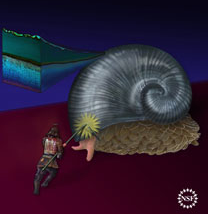Newly discovered snail shell may offer insight for engineers


A mollusk discovered just a decade ago called the scaly-foot gastropod doesn’t sound like the toughest of creatures. But researchers have found that its armor could help engineers improve load-bearing and protective materials in everything from aircraft hulls to sports equipment.
The snail has an unusual tri-layered shell including a highly calcified inner layer and a thick organic layer. But it’s the exterior layer, fused with granular iron sulfide, which most excited researchers at the National Science Foundation-supported Materials Research Science and Engineering Center at the Massachusetts Institute of Technology. The layer structure could be important in mollusk-inspired vehicle or personnel armor construction.
A report, "Protection mechanisms of the iron-plated armor of a deep sea hydrothermal vent gastropod," appears this week in the Proceedings of the National Academy of Sciences.
The gastropod mollusk lives in the Kairei Indian hydrothermal vent field, two-and-a-half miles below the central Indian Ocean. The vent field is a series of deep gashes in the planet’s surface along a volcanic mountain chain below the ocean. It was discovered there for the first time in 1999.
"Hydrothermal vent fluids possess high concentration of sulfides and metals, but this mollusk is unique in that it incorporates materials plentiful to vent field into its shell structure," said MIT project leader Christine Ortiz. "We were interested in looking at the structure and properties of the individual layers and seeing how they behave mechanically.”
The researchers looked into how the shell helps protect the animal from predators, which could give them new ideas for materials that may be used for cars, trucks and military applications. Some of its natural predators include the cone snail (which uses a harpoon-like tooth to attempt penetration before injecting it with a paralyzing venom) and crabs known to grab gastropods with their claws and attempt to puncture or squeeze their shells for days until the shells break.
To test the shell's properties, researchers performed experiments that simulated predatory attacks using both computer models and indentation testing, which involved hitting the top of shells with the sharp tip of a probe to measure the shell's hardness and stiffness.
The research found that each layer of the “exoskeleton is responsible for distinct and multifunctional roles in mechanical protection," Ortiz and her colleagues write in the report. The testing reveals that the shell is "advantageous for penetration resistance, energy dissipation, mitigation of fracture and crack arrest, reduction of back deflections and resistance to bending and tensile loads." Ortiz said the findings show that the scaly-foot gastropod is more efficient in protecting itself than the typical mollusk.
This post was originally published on Smartplanet.com